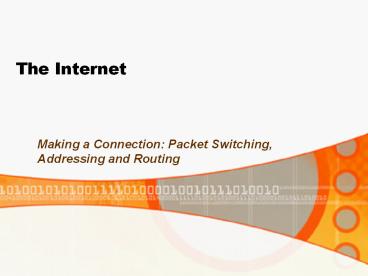The Internet - PowerPoint PPT Presentation
Title: The Internet
1
The Internet
- Making a Connection Packet Switching, Addressing
and Routing
2
Host Computer or Terminal
An Internet
Router
3
The Internet
- The Internet, or more correctly,
- a digital packet-switched network using the
TCP/IP set of protocols, - is
- A collection of hosts (computers and other
information devices) - connected by a variety of digital communications
networks, consisting of - digital communication links and
- switches, which are called routers.
4
Protocols
- Information is transmitted on the Internet as
binary information, 1s and 0s, under the
control of standardized procedures called
protocols.
5
The TCP/IP Suite of Protocols
- Originated with ARPANET and DDN to meet US DoD
requirements - Survivability
- no central point of failure security
- Network interoperability
- accommodate heterogeneous networks and equipment
- Ability to handle surge traffic
- Allow priority
- Be always available
6
Sending Information on the Internet
- Every entity (computer or router) on the Internet
has an address. - The address is a 32-bit binary number
- 10000110010101011111111011100011
- The IP address is usually expressed in dotted
decimal form - 134.117.254.227
- Part of the address is the NetID and the
remainder the HostID
7
Packets
- The message to be sent is packaged into packets
- A packet is a like an envelope that holds a block
of data - Each packet includes
- The address of the sender
- The address of the destination
8
- If the message is short
- it is sent in one packet
- If not
- it is fragmented and
- sent in a secession of packets.
9
Routing (Switching)
- Packets are sent independently from router to
router - Each router determines the next router to be used
by consulting a local directory called a routing
table
10
Routing at Host
- If the NetID is the same as that of the
originating host, the packet is handled locally - IP address is converted to the physical address
of the host and the packet delivered - If not the same, a memory-resident routing table
is consulted to determine next recipient of the
packet
11
Routing at Router
- The NetID is analyzed to determine if this is
last hop. - If not, the IP of the local router (using
memory-resident tables) selects the best path to
the destination - Packet is encapsulated again and sent one hop
closer to final destination - And so on
12
Routing Information
- Hosts maintain sufficient information to forward
packets to other hosts or interior routers within
the same network - Interior routers maintain sufficient information
to forward packets to hosts within the same
system - Exterior routers maintain sufficient information
to forward packets to other interior or exterior
routers
13
Routing Tables
- Each router keeps its memory-resident tables with
an optimum path to every destination in the
system - Routing-table update involves exchange of routing
table information between routers using a
built-in data communications system called ICMP. - Every router in the Internet does this call the
time!!!!
14
Internet Control Message Protocol ICMP
- Provides feedback about problems in the
communications environment - Error reporting
- Reachability testing
- Congestion Control
15
Datagram Delivery
16
Error Control
- The network makes no effort to detect or correct
errors in the transmitted data. - It is up to the recipient to detect errors and
ask for retransmission. - This end-to-end task is handled by TCP, or the
Transmission Control Protocol
17
Transmission Control Protocol (TCP)
- TCP provides traditional connection oriented data
communications service to programs - the reliable
stream transport service - TCP provides a virtual circuit, called a
connection - provides flow control, error checking and
interrupt capability
18
TCP Services
- Multiplexing
- Connection Management
- establish
- maintain
- terminate
- Data Transport
- Full-duplex
- Timely
- Ordered
- Labeled
- Flow controlled
- Error checked
19
The Domain Name Service - DNS
- DNS is a hierarchical collection of directories
(databases) that play a vital role in the
Internet. - DNS is the directory of IP addresses, that
contains the names associated with IP addresses. - Names, like sce.carleton.ca allow people to use
the Internet.
20
Finding an IP Address
- When ask my browser to open a web page at
www.sce.carleton.ca, a query is sent by my
computer to the nearest DNS server (at my ISP) - If it knows the IP address it sends it back to my
computer, otherwise it sends a query to the next
level DNS server, maybe .ca - This continues until an answer is found or not.
21
- When a match is found, say 134.117.4.60 or
whatever, the IP address is sent to my computer,
which sends a connect message to the web site
using this IP address. - Every interaction with the Internet goes through
the same process. - How can the Internet sustain and increase - its
capacity????
22
Domain Name Service
23
Moving on
24
Paths to Evolution
- Fundamental Technologies
- Electronics
- Communications
- Software
- Systems Engineering
- Provide better ways
- to organize and use
- faster processors with
- more memory
- at lower cost































